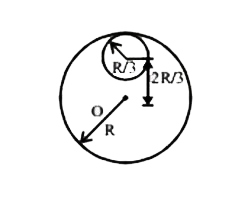The radius of gyration of a uniform disc of radius R, about an axis passing through a point R2 away from the centre of disc, and perpendicular to the plane of disc is:
√1320R
√2340R
√2320R
√1340R
The correct Answer is:A
To find the radius of gyration k of a uniform disc of radius R about an axis passing through a point R2 away from the center of the disc and perpendicular to the plane of the disc, we can follow these steps:
Step 1: Define the mass and moment of inertia
Let the mass of the disc be m. The moment of inertia I of a uniform disc about its center is given by:
Icenter=12mR2
Step 2: Use the parallel axis theorem
To find the moment of inertia about the new axis that is R2 away from the center, we can use the parallel axis theorem:
I=Icenter+md2
where d is the distance from the center to the new axis. Here, d=R2.
Step 3: Substitute values into the equation
Substituting the values into the equation:
I=12mR2+m(R2)2
Calculating (R2)2:
(R2)2=R24
Thus, we have:
I=12mR2+m⋅R24
Step 4: Combine the terms
Now, we combine the terms:
I=12mR2+14mR2=(24+14)mR2=34mR2
Step 5: Relate moment of inertia to radius of gyration
The moment of inertia can also be expressed in terms of the radius of gyration k:
I=mk2
Setting the two expressions for I equal gives:
mk2=34mR2
Step 6: Solve for k2
Dividing both sides by m:
k2=34R2
Step 7: Take the square root to find k
Taking the square root of both sides:
k=√34R=√32R
Final Answer
Thus, the radius of gyration k of the disc about the given axis is:
k=√32R
---
Let the mass of the disc be m. The moment of inertia I of a uniform disc about its center is given by:
Icenter=12mR2
To find the moment of inertia about the new axis that is R2 away from the center, we can use the parallel axis theorem:
I=Icenter+md2
where d is the distance from the center to the new axis. Here, d=R2.
Substituting the values into the equation:
I=12mR2+m(R2)2
Calculating (R2)2:
(R2)2=R24
Thus, we have:
I=12mR2+m⋅R24
Now, we combine the terms:
I=12mR2+14mR2=(24+14)mR2=34mR2
The moment of inertia can also be expressed in terms of the radius of gyration k:
I=mk2
Setting the two expressions for I equal gives:
mk2=34mR2
Dividing both sides by m:
k2=34R2
Taking the square root of both sides:
k=√34R=√32R
Thus, the radius of gyration k of the disc about the given axis is:
k=√32R
Topper's Solved these Questions
Similar Questions
The radius of gyration of a uniform solid sphere of radius R., about an axis passing through a point R2 away from the centre of the sphere is:
View SolutionThe radius of gyration of a uniform rod of length l , about an axis passing through a point l8away form the centre of the rod , and perpendicular to it is:
View SolutionThe radius of gyration of a uniform rod of length l , about an axis passing through a point l8away form the centre of the rod , and perpendicular to it is:
View SolutionRadius of gyration of a uniform circular disc about an axis passing through its centre of gravity and perpendicular to its plane is
View SolutionThe ratio of radii of gyration of a circular ring and a circular disc, of the same mass and radius about an axis passing through their centres and perpendicular to their planes are
View SolutionMoment of inertia of a uniform quarter disc of radius R and mass M about an axis through its centre of mass and perpendicular to its plane is :
View SolutionMoment of inertia of a uniform quarter disc of radius R and mass M about an axis through its centre of mass and perpendicular to its plane is :
View SolutionIf a circular concentric hole is made on a disc then about an axis passing through the centre of the disc and perpendicular to its plane
View SolutionA disc has mass 9 m. A hole of radius R/3 is cut from it as shown in the figure. The moment of inertia of remaining part about an axis passing through the centre 'O' of the disc and perpendicular to the plane of the disc is :

View SolutionA uniform brass disc of radius a and mass m is set into spinning with angular speed ω0 about an axis passing through centre of disc and perpendicular to the palne of disc. If its temperature increases from θ∘1C to θ∘2C with out disturbing the disc, what will be its new angular speed ?
View Solution
